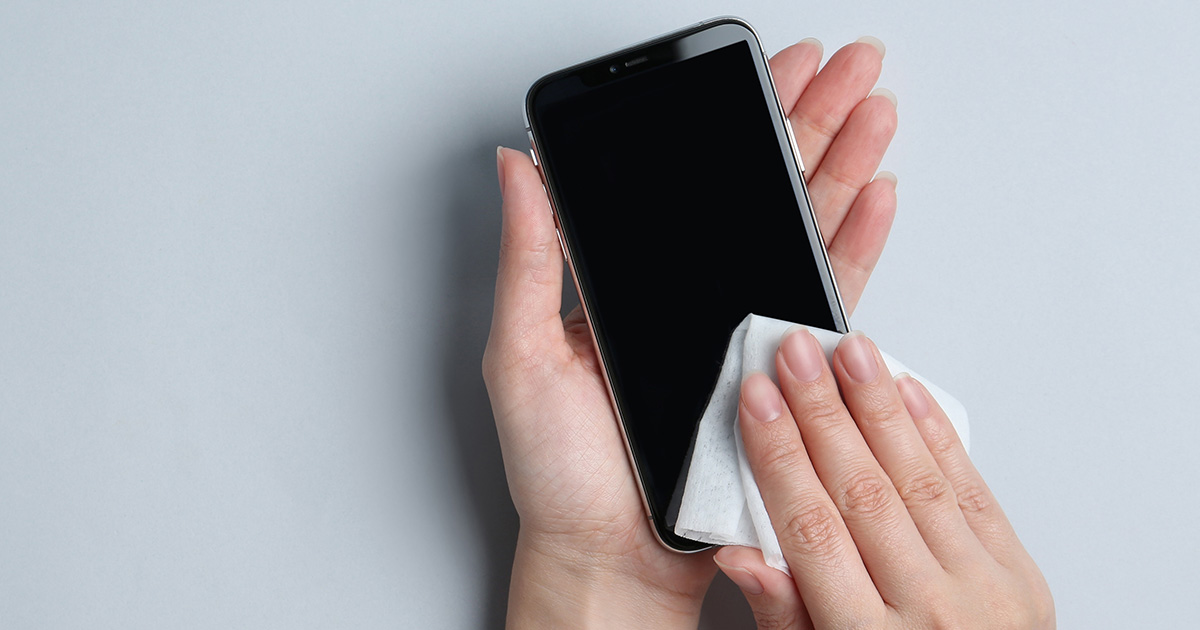1 Oct 2023
Georgia Vinall draws on several studies to remind readers about cleaning your mobile phone – and every other fomite in your pocket – in the workplace.

Image © New Africa / Adobe Stock

It has been a few years since myself and the University of Bristol published a paper on the contamination of personal electronic devices (PEDs)1.
It shocked a fair few (including myself) and prompted a more structured approach into regular disinfection of staff smartphones. However, a few years fly by, multiple new projects rumble on and suddenly we’re back in our old ways – our phones sitting in our pockets like the Petri dishes they were before.
Tivers, Jeffery, Cogan and I found that 85% of staff in a large university hospital used a smartphone every day while on clinics1. They’re so useful for things like timing pulses, recording notes, calculating pre-meds and checking the NOAH Compendium (there’s an app for that).
The latest craze seems to be communicating with a large staff set via Teams or other messaging services. It’s been a game changer, allowing me to message a quick photo of a wound to a clinician, who I would have previously spent a good 15 minutes attempting to track down – where do they hide?
One slight concern: staphylococci were found on 68% of these devices. And let’s not even go into the Pseudomonas cultures that we didn’t have space to report on.
Not only that, these staphs were pretty resistant to antimicrobials already. Vancomycin and oxacillin resistance were seen in 37% and 2% of isolated colonies, respectively. We even had four vancomycin-resistant, coagulase-positive staphylococci, which is a match made in heaven for antibiotic dodging. Similar results were found in multiple human hospitals2-5 and two other veterinary studies6,7 with resistance to other drugs such as clindamycin, ampicillin, ceftazidime and cefotaxime5,7.
Why was the rate so high? In total, 44% of staff never cleaned their device1. Of the few who did, only 6% cleaned theirs on a daily basis. This “cleaning” frequency can probably be reduced further as the disinfection methods ranged from antibacterial wipes to “rubbing on my sleeve”.
Now, it’s all well and good swabbing some bacteria and testing it, but I am aware that we didn’t look into the link between contamination and actual infections (between staff and/or patients). This could be a future study – any takers?
In the meantime, we should remember to treat these items with the same care and attention we would with other hospital-based fomites. We wouldn’t give two patients the same unwashed bedding or food bowl.
I come close to a heart attack when someone tries to clip a patient with contaminated clippers, so why am I holding a patient with one hand while timing their pulse on my phone in the other, when I don’t think I’ve cleaned it since last Wednesday? And, let’s be honest, those things go into more toilet cubicles than we dare to admit.
When investigating the best ways to fully disinfect a PED, Howell et al8 found that dry microfibre cloths (recommended by most PED manufacturers) were found to be insufficient in completely removing or significantly reducing the bacterial load8.
Very recently, Zurita et al7 have demonstrated the efficacy of the Sani-Cloth CHG 2% wipe on 25 hospital-issued iPads7. They found all iPads were bacteria free for up to 12 hours post-disinfection when using these wipes appropriately. This was still the case when the iPad was used on the wards during the 12-hour period.
Their technique involves thoroughly wiping the device for approximately 10 seconds with the CHG 2% wipe and allowing to air dry. Simple, right?
Although this study limited their disinfection method to one type of wipe, it is a fair assumption to make that, if this particular brand of wipe is not available to a practice, disinfectant wipes with reliable, evidence-based results are a good starting point.
Therefore, disinfection of these devices is recommended every 12 hours using an antimicrobial wipe or spray, ensuring all surfaces have had sufficient contact time (refer to your disinfectant manufacturer’s data sheet for dilutions, contact times and which pathogens are covered).
The other thing to remember (as always) is our hand hygiene.
The World Health Organization hand hygiene guidelines talk about the five key moments in which we should wash our hands:
It’s always good to remember to check we have lots of easily accessible hand washing stations and posters above them outlining the best technique for full disinfection. The cleaner our hands are, the cleaner our phones are – not to mention the reduced risk in pathogenic transmission.
To summarise, these devices are undoubtedly useful within a clinical setting and banning them is counterproductive. However, they should be remembered when considering infection control and regular cleaning is recommended.
The following are the latest achievable steps in reducing the risk of our pocket fomites:
I hope this helps and that you all have squeaky clean phones.